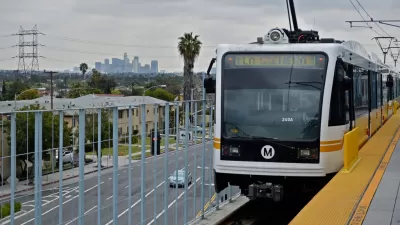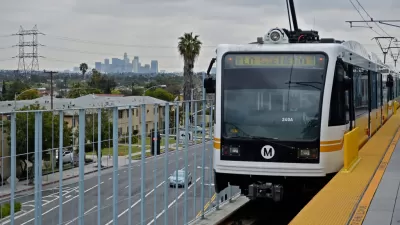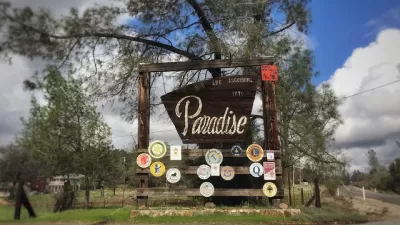Two new light rail extensions opened in Los Angeles within two and a half months. Ridership is soaring on the Gold Line extension and preliminary reports look good for the Expo Line, but new riders experience problems familiar to long-time riders.

On March 5, the $1 billion, 11.5-mile Gold Line Foothill Extension serving six stations in the San Gabriel Valley of Los Angeles County (an area of 2 million people and 47 neighborhoods east of the City of Los Angeles) opened with much fanfare. Two and a half months later, on May 20, the long-awaited $1.5 billion, 6.6-mile Phase 2 of the Metro Expo Line opened, serving seven new stations from Culver City to Santa Monica.
Steve Scauzillo of the San Gabriel Valley Tribune reports on packed Gold trains since the Foothill Extension opened, partly due to a shortage of rail cars. And only every other train departing Union Station served the six-station extension. Conditions should improve June 27.
Commuting in L.A. — Pick your poison
A very depressing account of riding the rails was written by Joe Mathews who writes the Connecting California column for Zocalo Public Square. His column was published in San Francisco Chronicle as well.
I wish I could report that my own life is better now that I ride the brand-new Metro Expo Line extension to work in Santa Monica...But I’m a rail commuter in Southern California now, so I no longer have time for fairy tales.
Mathews begins what turned into an unsustainable 2½-hour commute at the Pasadena Gold Line station. After "waiting 20 minutes for a train to arrive — the wait is supposed to be six — the train took 45 minutes to reach Union Station downtown (it should take 30)."
There was another 10-minute delay when I had to switch to the subway to go three stops to pick up the new Expo Line. [See Metro rail & transit map (PDF)]
Suggested solutions
Mathews make many helpful observations on how to speed-up the the advertised 48-minute trip to Santa Monica, which took him an hour, that were discussed in a thoughtful piece by Ethan Elkind. "[I]f the City of Los Angeles can change the signal priority and street configuration, the trains will run a bit faster through downtown," writes Elkind who offers an immediate though certainly controversial solution to accelerate service: Shut down underperforming stations.
For anyone who’s ridden the line, it’s obvious there are some station areas that are low-rise and therefore low-ridership. Absent further development around them, Metro should shut them down and speed the ride for the majority of riders.
The Expo Line runs 15.2 miles, and it shouldn’t take an hour. 15 miles per hour just isn’t providing much benefit over driving, if any. And it won’t make the line sustainable in the long run. So that’s why policy makers need to consider immediate action to improve the travel times.
"When I drove to work one day later last week, the commute was still miserable—two-and-a-half hours round-trip," continues Mathews.
But that was much faster than it had been on Metro. And my body felt fresher and I got to listen to the radio.
Which is better—car or rail? Both are awful, just in different ways. I console myself in knowing that now at least I can pick my poison.
Even an incredibly positive report on her first commute trip on the Expo Line ended on a downbeat note, not just by the writer, Los Angeles Times columnist and blogger Robin Abcarian, but also by her colleague, Christopher Hawthorne, The Times’ architecture critic whom she met on the train on her second day riding the new extension.
...we agreed that for us, anyway, the Expo Line was probably impractical for a daily commute. On Monday, it had taken me nearly an hour and 40 minutes to get from my door to my desk. That compares to my usual 45 minutes or so in the car.
“But you know,” Hawthorne said, “we never would have bumped into each other if we were sitting in our cars.”
Hat tip to Metro Library's L.A. Transportation Headlines.
FULL STORY: Light Rail Successes Draw Attention to L.A. Metro's Rail Problems

Study: Maui’s Plan to Convert Vacation Rentals to Long-Term Housing Could Cause Nearly $1 Billion Economic Loss
The plan would reduce visitor accommodation by 25,% resulting in 1,900 jobs lost.

North Texas Transit Leaders Tout Benefits of TOD for Growing Region
At a summit focused on transit-oriented development, policymakers discussed how North Texas’ expanded light rail system can serve as a tool for economic growth.

Why Should We Subsidize Public Transportation?
Many public transit agencies face financial stress due to rising costs, declining fare revenue, and declining subsidies. Transit advocates must provide a strong business case for increasing public transit funding.

How to Make US Trains Faster
Changes to boarding platforms and a switch to electric trains could improve U.S. passenger rail service without the added cost of high-speed rail.

Columbia’s Revitalized ‘Loop’ Is a Hub for Local Entrepreneurs
A focus on small businesses is helping a commercial corridor in Columbia, Missouri thrive.

Invasive Insect Threatens Minnesota’s Ash Forests
The Emerald Ash Borer is a rapidly spreading invasive pest threatening Minnesota’s ash trees, and homeowners are encouraged to plant diverse replacement species, avoid moving ash firewood, and monitor for signs of infestation.
Urban Design for Planners 1: Software Tools
This six-course series explores essential urban design concepts using open source software and equips planners with the tools they need to participate fully in the urban design process.
Planning for Universal Design
Learn the tools for implementing Universal Design in planning regulations.
City of Santa Clarita
Ascent Environmental
Institute for Housing and Urban Development Studies (IHS)
City of Grandview
Harvard GSD Executive Education
Toledo-Lucas County Plan Commissions
Salt Lake City
NYU Wagner Graduate School of Public Service




























